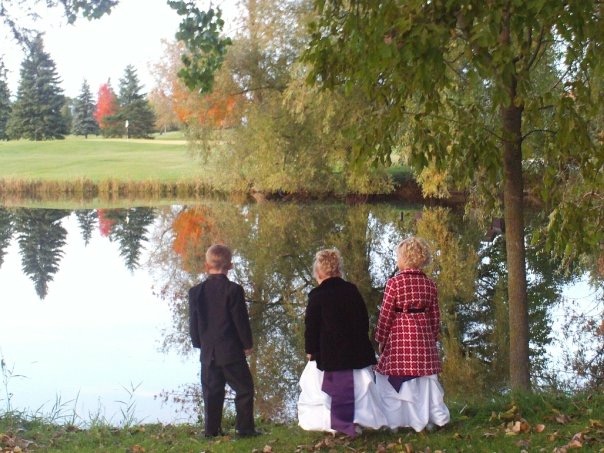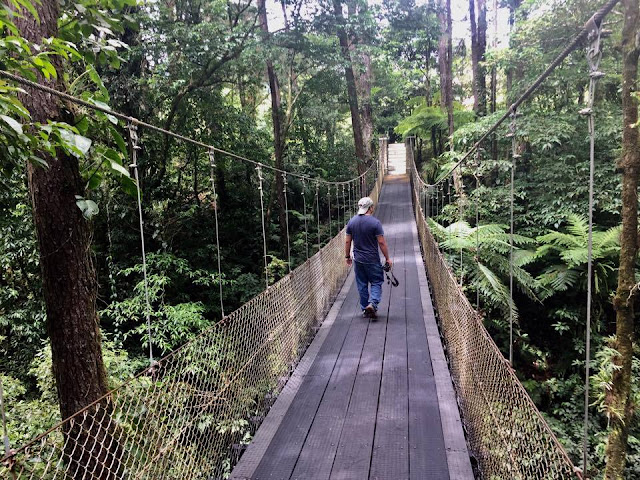The winter winds receded. Her lands awakened with green knowing. A myriad of blossom color once again filled in the empty spaces of her backyard. There she eagerly waited on that wonderful spring day in May with her coffee and cigarette. Where were they?, she thought worriedly.
Over the years, she perfected a place for the hummingbirds and orioles to nest. In her home, she eagerly mixed her magic potions of sugar water and orange mix for her favorite birds. She'd fill up her feeders with grape jams enticing tanagers and orioles alike to visit. In fact, her home became a diner stop on the migration route. But over the years, several of those birds discovered that they could count on her for food to help them raise their young. So they stayed and made her backyard their home.
Generations and decades later, the now older lady waited on her birthday for the arrival of her hummingbirds. How many years had she done this ritual? She couldn't remember nor did she care. Every special experience was blurred into one lifetime moment during her conversations with family. And during her chats with her grandson, they'd discuss it all.
These two had spent a lifetime together. He was luckier than most people because he had a grandma who was always there for him. At times, he thought she was immortal but knew deep down that nothing lasts forever. Many times during his visit home, he'd sit outside and sip a red beer with her by the feeders. They'd speak fondly of the past, gossip about the present and wonder about the future. And all while watching her backyard birds. Her lands were magical and ALIVE. So many birds. So many wild things. She was very much a part of that land as it was of her. IT was her world for decades and she simply acknowledged this other family member as "THE LAND".
As a child, the grandson helped her garden. There he learned the secrets about growing cherry tomatoes, kohlrabis, radishes and onions. Sometimes a Snapping Turtle would try and lay eggs in the garden. Sometimes, a little country mouse would nibble on her sacred radishes. She'd get frustrated and proclaim that those "damned rabbits" were eating her carrots. They'd then proceed to fence off the "carrot section".
And when they weren't gardening together, he'd wander off and chase fireflies and frogs. On a warm June night before a rain, the swampy forest next to her house came alive with sparkling lights. During the day, he'd run along the river and look for critters around the bee house. He'd grab an apple off the tree and eat around the worms. The deer liked it there too as they'd feast from the tasty carpet of fruit.
During the winter, the river would freeze over. Winter scenes, like those imagined on Hallmark Cards, were real. Ice skaters seamlessly moved in their scarves and mittens against the muted grays and whites of the forest. At night, some would get on their snow mobiles and race.
And at the end of their fun on the LAND, she'd be waiting for them at the house with a drink. In winter, she'd have hot chocolate for the grandkids and cocktails for the adults. In summer, it was a cool slice of melon. In fall, it was apple cider. During holidays, a nice frosty mint grasshopper. On boating trips with his Grandpa, she'd make their lunches. There were always fresh vegetables to eat. But breakfast was always the best. There they would sit and plan their days out. As a child, each day was an memorable event.
She, along with his grandpa, nurtured and fostered the love of all things nature and outdoors. It wasn't a special event. It was part of every day country life. Cleaning up the river, mowing the huge tracts of grass, cleaning up the autumn leaves(not the grandson's favorite activity!) or working out in the garden were every day things. It was all woven together like the barkcloth of the past.
This year, two days after her birthday, the hummingbirds arrived just as she had predicted. She called her grandson and let him know that they had returned. She was relieved and happy. A few days later, a red and black tanager was also feeding from her grape jelly. She excitedly told him about the experience. "Grandma!! You just saw a Scarlet Tanager!" She said it was one of the most beautiful birds she had ever seen. Well, next to her Baltimore Orioles.
Two months had passed at Grandma's house since the hummingbirds had arrived. But this time it was the grandson who reached for the empty hummingbird feeder for the last time. He was scolded by an angry Ruby-throated Hummingbird. Where is my food??!! The grandson laughed a little to himself and felt terrible that his feeder had been empty for several days. As he put the new nectar out, the hummer was joined by a younger one. It made him happy and sad all at once. Walking down the patio steps for the last time, he looked back and tried to memorize all the little details. So many memories. Standing under the ancient black walnut tree one last time, he said his farewells to the land and his grandmother. Thank you for everything you taught me Grandma. I love you.
Over the years, she perfected a place for the hummingbirds and orioles to nest. In her home, she eagerly mixed her magic potions of sugar water and orange mix for her favorite birds. She'd fill up her feeders with grape jams enticing tanagers and orioles alike to visit. In fact, her home became a diner stop on the migration route. But over the years, several of those birds discovered that they could count on her for food to help them raise their young. So they stayed and made her backyard their home.
Generations and decades later, the now older lady waited on her birthday for the arrival of her hummingbirds. How many years had she done this ritual? She couldn't remember nor did she care. Every special experience was blurred into one lifetime moment during her conversations with family. And during her chats with her grandson, they'd discuss it all.
These two had spent a lifetime together. He was luckier than most people because he had a grandma who was always there for him. At times, he thought she was immortal but knew deep down that nothing lasts forever. Many times during his visit home, he'd sit outside and sip a red beer with her by the feeders. They'd speak fondly of the past, gossip about the present and wonder about the future. And all while watching her backyard birds. Her lands were magical and ALIVE. So many birds. So many wild things. She was very much a part of that land as it was of her. IT was her world for decades and she simply acknowledged this other family member as "THE LAND".
As a child, the grandson helped her garden. There he learned the secrets about growing cherry tomatoes, kohlrabis, radishes and onions. Sometimes a Snapping Turtle would try and lay eggs in the garden. Sometimes, a little country mouse would nibble on her sacred radishes. She'd get frustrated and proclaim that those "damned rabbits" were eating her carrots. They'd then proceed to fence off the "carrot section".
And when they weren't gardening together, he'd wander off and chase fireflies and frogs. On a warm June night before a rain, the swampy forest next to her house came alive with sparkling lights. During the day, he'd run along the river and look for critters around the bee house. He'd grab an apple off the tree and eat around the worms. The deer liked it there too as they'd feast from the tasty carpet of fruit.
During the winter, the river would freeze over. Winter scenes, like those imagined on Hallmark Cards, were real. Ice skaters seamlessly moved in their scarves and mittens against the muted grays and whites of the forest. At night, some would get on their snow mobiles and race.
And at the end of their fun on the LAND, she'd be waiting for them at the house with a drink. In winter, she'd have hot chocolate for the grandkids and cocktails for the adults. In summer, it was a cool slice of melon. In fall, it was apple cider. During holidays, a nice frosty mint grasshopper. On boating trips with his Grandpa, she'd make their lunches. There were always fresh vegetables to eat. But breakfast was always the best. There they would sit and plan their days out. As a child, each day was an memorable event.
She, along with his grandpa, nurtured and fostered the love of all things nature and outdoors. It wasn't a special event. It was part of every day country life. Cleaning up the river, mowing the huge tracts of grass, cleaning up the autumn leaves(not the grandson's favorite activity!) or working out in the garden were every day things. It was all woven together like the barkcloth of the past.
This year, two days after her birthday, the hummingbirds arrived just as she had predicted. She called her grandson and let him know that they had returned. She was relieved and happy. A few days later, a red and black tanager was also feeding from her grape jelly. She excitedly told him about the experience. "Grandma!! You just saw a Scarlet Tanager!" She said it was one of the most beautiful birds she had ever seen. Well, next to her Baltimore Orioles.
Two months had passed at Grandma's house since the hummingbirds had arrived. But this time it was the grandson who reached for the empty hummingbird feeder for the last time. He was scolded by an angry Ruby-throated Hummingbird. Where is my food??!! The grandson laughed a little to himself and felt terrible that his feeder had been empty for several days. As he put the new nectar out, the hummer was joined by a younger one. It made him happy and sad all at once. Walking down the patio steps for the last time, he looked back and tried to memorize all the little details. So many memories. Standing under the ancient black walnut tree one last time, he said his farewells to the land and his grandmother. Thank you for everything you taught me Grandma. I love you.





















































